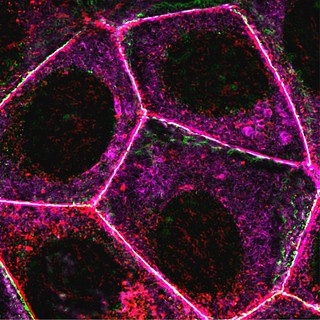University of Queensland researchers have discovered a new signalling pathway that controls cell adhesion, an important process that is disrupted in diseases such as skin cancer and inflammation.
Dr Rashmi Priya from UQ’s Institute for Molecular Bioscience (IMB) said the research clarifies the role of the protein myosin in tissue integrity.
“Myosin is found at cell adhesion points and we know it plays a necessary role in regulating how cells stick together to form coherent tissues,” she said.
“Our research has shown this is because myosin protects a signalling molecule called Rho, an important switch that stabilizes adherence points between cells.
“Rho affects many processes within the body so must be very tightly controlled.
“Too much or too little, or in the wrong place, can lead to cancer and inflammation.
“Myosin helps to control and protect Rho by blocking a molecule that inactivates Rho and can therefore cause tissues to break down in diseases such as cancer.”
Professor Alpha Yap, who led the research team, said cell adhesion was not a simple glue.
“The cells in all the tissues of our body die and have to be replaced as regularly as every 24 hours in the intestinal system,” he said.
“For this to happen, adhesion between cells must be carefully broken down and rebuilt, and we now have a better understanding of the pathway controlling this.
“Losing myosin function contributes to the progression of skin cancer, and our new work gives an important clue as to why this might happen when Rho signalling is disrupted, causing a loss of cell adhesion and tissue integrity.”
The researchers said that the Australian Cancer Research Foundation Cancer Biology Imaging Facility at IMB played a vital role in this research.
“The Facility allowed us to develop and test new tools for studying Rho and myosin in cells,” Professor Yap said.
The Facility is one of the largest and most comprehensively equipped facilities in Australia for both the imaging and screening of chemical and biological libraries.
The research was published today in Nature Cell Biology.
Media: IMB Communications, +61 7 3346 2134, 0418 575 247, communications@imb.uq.edu.au




